Lake Hemet is a crystal clear man-made lake surrounded by the spectacular scenery of the San Jacinto Mountains. Located approximately 25 miles east of the present-day town of Hemet, Lake Hemet is part of the San Bernardino National Forest and nestled in the San Jacinto Valley. The first people known to inhabit the valley were the Cahuilla Indians. When the Spanish began settling the area in the early 1800s, it became a cattle ranch for Mission San Luis Rey and was called Rancho San Jacinto. In 1842, during the period of Secularization when the Mexican government broke up the missions, the land was awarded to Jose Antonio Estudillo.
The development of the San Jacinto Valley can be attributed to two primary visionaries, Abbott Kinney and Edward L. Mayberry. When author Helen Hunt Jackson visited the San Jacinto Valley in 1883 to gather material on a group of Cahuilla Indians who were living on the east side of the San Jacinto River (see Garner Ranch), she was accompanied by her interpreter, Abbott Kinney.
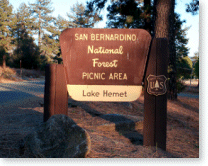 During their visit, Jackson and Kinney stayed at various ranches and met numerous valley and mountain residents, notably Charles Thomas and Hancock McClung Johnston. Thomas and Johnston owned ranches in the San Jacinto Mountains, where they raised racehorses in what was then called Hemet Valley. Many of the Cahuillas worked on Thomas' Ranch, and among the most famous of them were Juan Diego and Ramona Lubo, whose life story would later be immortalized in Helen Hunt Jackson's famous novel Ramona. It was undoubtedly from the two ranchers, and perhaps others, that Abbott Kinney learned about an 1882 court decision that partitioned lands of the old Rancho San Jacinto to various individuals, some of whom envisioned making a profit from their holdings if the region could obtain an adequate water supply. Kinney recognized a lucrative opportunity and determined that a reservoir could be built in Hemet Valley by constructing a dam across the South Fork of the San Jacinto River. After many visits to the Valley, Kinney and Johnston decided to incorporate and acquire valley lands. They entered into an agreement with Francisco Estudillo, youngest son of the original owner of the old Rancho San Jacinto, to buy 3,000 acres of Estudillo land. It was from this tract of land that the town of Hemet eventually evolved. For reasons that are not entirely clear, the transaction fell through, and on October 15, 1886, Estudillo sold the 3,000 acres to three other men, Edward L. Mayberry, Albert H. Judson and Peter Potts, under the same conditions of the previous agreement.
During their visit, Jackson and Kinney stayed at various ranches and met numerous valley and mountain residents, notably Charles Thomas and Hancock McClung Johnston. Thomas and Johnston owned ranches in the San Jacinto Mountains, where they raised racehorses in what was then called Hemet Valley. Many of the Cahuillas worked on Thomas' Ranch, and among the most famous of them were Juan Diego and Ramona Lubo, whose life story would later be immortalized in Helen Hunt Jackson's famous novel Ramona. It was undoubtedly from the two ranchers, and perhaps others, that Abbott Kinney learned about an 1882 court decision that partitioned lands of the old Rancho San Jacinto to various individuals, some of whom envisioned making a profit from their holdings if the region could obtain an adequate water supply. Kinney recognized a lucrative opportunity and determined that a reservoir could be built in Hemet Valley by constructing a dam across the South Fork of the San Jacinto River. After many visits to the Valley, Kinney and Johnston decided to incorporate and acquire valley lands. They entered into an agreement with Francisco Estudillo, youngest son of the original owner of the old Rancho San Jacinto, to buy 3,000 acres of Estudillo land. It was from this tract of land that the town of Hemet eventually evolved. For reasons that are not entirely clear, the transaction fell through, and on October 15, 1886, Estudillo sold the 3,000 acres to three other men, Edward L. Mayberry, Albert H. Judson and Peter Potts, under the same conditions of the previous agreement.
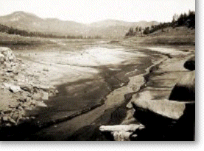 By December 1886, Mayberry, Judson and Potts had sold some of their interests in the Estudillo tract to Hancock M. Johnston. During the same month, these four men and a wealthy San Francisco capitalist, William F. Whittier, acquired another 3,000 acres from H.T. Hewitt, a San Jacinto hotel and shop owner. The Hewitt land was located approximately one mile north of Park Hill and adjacent to and east of the Estudillo tract. The agreement with Hewitt included the stipulation that a town site would be located on or near Park Hill. Although originally conceived by Abbott Kinney and Hancock M. Johnston, the town of Hemet would now evolve under the watchful eye and financing of Edward L. Mayberry and William F. Whittier. The acquisition of the Hewitt land led Mayberry, Whittier, and their partners to organize the Lake Hemet Water and Land Companies on January 27, 1887. The newly incorporated companies elected A.H. Judson as president, with Edward L. Mayberry and R.K. Wood elected vice present and secretary, respectively. Mayberry and Whittier would hold the majority of stock in both companies. On July 3, 1888, William F. Whittier replaced A.H. Judson as president of the company, and Judson eventually retired on November 22, 1888.
By December 1886, Mayberry, Judson and Potts had sold some of their interests in the Estudillo tract to Hancock M. Johnston. During the same month, these four men and a wealthy San Francisco capitalist, William F. Whittier, acquired another 3,000 acres from H.T. Hewitt, a San Jacinto hotel and shop owner. The Hewitt land was located approximately one mile north of Park Hill and adjacent to and east of the Estudillo tract. The agreement with Hewitt included the stipulation that a town site would be located on or near Park Hill. Although originally conceived by Abbott Kinney and Hancock M. Johnston, the town of Hemet would now evolve under the watchful eye and financing of Edward L. Mayberry and William F. Whittier. The acquisition of the Hewitt land led Mayberry, Whittier, and their partners to organize the Lake Hemet Water and Land Companies on January 27, 1887. The newly incorporated companies elected A.H. Judson as president, with Edward L. Mayberry and R.K. Wood elected vice present and secretary, respectively. Mayberry and Whittier would hold the majority of stock in both companies. On July 3, 1888, William F. Whittier replaced A.H. Judson as president of the company, and Judson eventually retired on November 22, 1888.
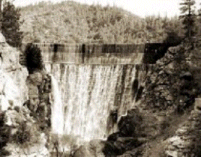 The two companies allowed the partnership to acquire land and water rights from the San Jacinto Valley. On February 22, 1887, an agreement was reached between Lake Hemet Water Company and Fairview Land and Water Company regarding construction of a dam on the west end of Garner Valley for storing waters of the south fork of the San Jacinto River. A resolution was approved in June 1890, and on January 6, 1891, the Lake Hemet Water Company began building the dam that created Lake Hemet. During this time, the town of Hemet, which had been founded in 1887, began taking on a look of prosperity. When Lake Hemet Dam was finally completed on October 9, 1895, its 122.5-foot high arched structure was the largest solid masonry dam in the world. It would retain this distinction until the construction of Roosevelt Dam in Arizona in 1911.
The two companies allowed the partnership to acquire land and water rights from the San Jacinto Valley. On February 22, 1887, an agreement was reached between Lake Hemet Water Company and Fairview Land and Water Company regarding construction of a dam on the west end of Garner Valley for storing waters of the south fork of the San Jacinto River. A resolution was approved in June 1890, and on January 6, 1891, the Lake Hemet Water Company began building the dam that created Lake Hemet. During this time, the town of Hemet, which had been founded in 1887, began taking on a look of prosperity. When Lake Hemet Dam was finally completed on October 9, 1895, its 122.5-foot high arched structure was the largest solid masonry dam in the world. It would retain this distinction until the construction of Roosevelt Dam in Arizona in 1911.
While diminutive by today's standards, the Lake Hemet Dam was an extraordinary undertaking in the late 1800s. According to Mary E. Whitney, a former Lake Hemet Municipal Water District employee and historian, dam construction was not able to begin until a road wide enough to accommodate supply wagons and six-mule teams was created from Hemet to Garner Valley. "Designed by Mayberry, but constructed by Proctor and Marriage of San Jacinto, the road was necessarily steep with many switchbacks so six-mule teams could rest while maneuvering their ascending loads of supplies, equipment and 400-pound barrels of cement," Whitney wrote in an article published in The Valley Chronicle. Early historical accounts describe that freighters encountered grades as steep as 18 percent on portions of the canyon road.
 In order to create the reservoir site, one million board feet of lumber had to be cleared from the valley. Half of the wood was used for buildings and scaffolding at the dam; the other half was hauled down the canyon and used for flumes, additional scaffolding, and other needed structures. The next challenge in the project was the procurement of Portland cement, a type of cement which hardens under water. Since no Portland cement plants existed in the western United States, the cement had to be acquired from sources in Antwerp, Belgium, and shipped around South America
In order to create the reservoir site, one million board feet of lumber had to be cleared from the valley. Half of the wood was used for buildings and scaffolding at the dam; the other half was hauled down the canyon and used for flumes, additional scaffolding, and other needed structures. The next challenge in the project was the procurement of Portland cement, a type of cement which hardens under water. Since no Portland cement plants existed in the western United States, the cement had to be acquired from sources in Antwerp, Belgium, and shipped around South America
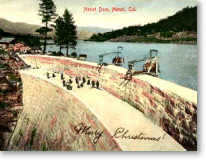 to the Port of San Diego. The cement was then transported by railroad to San Jacinto, where it was loaded onto the wagons that mule teams hauled up the steep, dusty mountain road. Once at the construction site, the cement was used to join together the thousands of 5- to 15-ton granite stones that comprised most of the dam. These huge granite stones were
quarried from the surrounding bluffs and then moved to the dam on steam engine carriers that were suspended by two sets of 800-foot cables strung across the canyon in opposite directions. Even though an extensive system was developed to deliver construction materials to the dam site to minimize delay, historical accounts indicate that in 1892 and 1893 bad weather and
to the Port of San Diego. The cement was then transported by railroad to San Jacinto, where it was loaded onto the wagons that mule teams hauled up the steep, dusty mountain road. Once at the construction site, the cement was used to join together the thousands of 5- to 15-ton granite stones that comprised most of the dam. These huge granite stones were
quarried from the surrounding bluffs and then moved to the dam on steam engine carriers that were suspended by two sets of 800-foot cables strung across the canyon in opposite directions. Even though an extensive system was developed to deliver construction materials to the dam site to minimize delay, historical accounts indicate that in 1892 and 1893 bad weather and
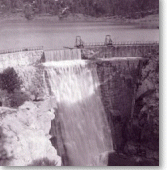 floods halted construction. The Lake Hemet Dam was completed on October 9, 1895, and helped capture the valued winter snowmelt and rainwater that eventually would be used to cultivate the apricot, walnut, olive and citrus groves of the San Jacinto Valley.
floods halted construction. The Lake Hemet Dam was completed on October 9, 1895, and helped capture the valued winter snowmelt and rainwater that eventually would be used to cultivate the apricot, walnut, olive and citrus groves of the San Jacinto Valley.
Edward L. Mayberry resigned as General Manager of Lake Hemet Water Company on January 25, 1898. Construction of a filtering plant was begun in December 1898, and on January 7, 1901, the Hemet Town Water Company was organized and purchased 160 water rights from Lake Hemet Water Company. A diversion dam was built on Strawberry Creek in September 1901, and in
January 1905 a 26-inch steel pipe was laid from the diversion dam on the South Fork to the North Fork of the San Jacinto River. In March 1906, water flowed over the Lake Hemet Dam for the first time since its completion ten years prior.
On January 20, 1910, the Town of Hemet was formally incorporated with 992 people. In 1911, a dam and intake house was constructed on the north fork of the San Jacinto River. After a major flood in January 1916 caused the loss of four miles of pipeline, flumes, and diversionary structures in the river canyon, the Lake Hemet Water Company in 1923 raised the height
of the dam to 135 feet. This improvement increased both the region's water reserves as well as its growth potential. More flooding occurred in February 1927 when an auxiliary dike failed during prolonged storming, while 1928 saw the formation of the Metropolitan Water District (MWD) of Southern California. In 1932, construction began on the Colorado River Aqueduct. When a prolonged drought in 1947 nearly dried up Lake Hemet, it was the Aqueduct that supplied the much-needed water to western Riverside County.
It was during the time of the Colorado River Aqueduct's construction that the entertainment industry took notice of Lake Hemet and the spectacular scenery of the surrounding San Jacinto Mountains. With panoramic vistas that readily doubled for the high sierras or Canadian Northwest,
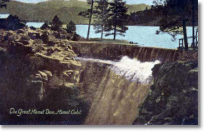 it is no surprise that Hollywood producers took advantage of Lake Hemet as a film location site. Particularly suitable to the B-Western genre, Lake Hemet was used as a backdrop in a number of oaters such as Robert N. Bradbury's The Man from Hell's Edges (1932) starring Bob Steele and Nancy Drexel, and Stars Over Arizona (1937) starring Jack Randall
and Kathleen Eliot; Joseph Kane's Heart of the Rockies (1937) starring Robert Livingston and Ray Corrigan, and Gold Mine In the Sky (1938) starring Gene Autry and Smiley Burnette; Frank McDonald's Jeepers Creepers (1939) starring Leon Weaver and Johnny Arthur;
it is no surprise that Hollywood producers took advantage of Lake Hemet as a film location site. Particularly suitable to the B-Western genre, Lake Hemet was used as a backdrop in a number of oaters such as Robert N. Bradbury's The Man from Hell's Edges (1932) starring Bob Steele and Nancy Drexel, and Stars Over Arizona (1937) starring Jack Randall
and Kathleen Eliot; Joseph Kane's Heart of the Rockies (1937) starring Robert Livingston and Ray Corrigan, and Gold Mine In the Sky (1938) starring Gene Autry and Smiley Burnette; Frank McDonald's Jeepers Creepers (1939) starring Leon Weaver and Johnny Arthur;
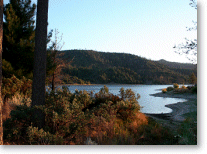 and Derwin Abrahams' Northwest Trail (1945) starring Bob Steele and Joan Woodbury. It is interesting to note that Robert N. Bradbury, director of The Man from Hell's Edges (1932), was Bob Steele's father. In addition, this film's production team was also the team responsible for John Wayne's "Lone Star" series produced by Monogram between 1933 and 1935. Monogram's Stars Over Arizona (1937) was filmed at Lake Hemet as well as at the Garner Ranch located across the highway from the lake. Heart of the Rockies (1937), produced by Republic, is part of "The Three Mesquiteers" series written by William Colt MacDonald. Lastly, Lippert's Northwest Trail (1945), whose plot involves a Canadian Mountie assigned to escort a woman to a remote outpost, is the only low-budget B-Western in this list to be filmed in Cinecolor (two-strip Technicolor).
and Derwin Abrahams' Northwest Trail (1945) starring Bob Steele and Joan Woodbury. It is interesting to note that Robert N. Bradbury, director of The Man from Hell's Edges (1932), was Bob Steele's father. In addition, this film's production team was also the team responsible for John Wayne's "Lone Star" series produced by Monogram between 1933 and 1935. Monogram's Stars Over Arizona (1937) was filmed at Lake Hemet as well as at the Garner Ranch located across the highway from the lake. Heart of the Rockies (1937), produced by Republic, is part of "The Three Mesquiteers" series written by William Colt MacDonald. Lastly, Lippert's Northwest Trail (1945), whose plot involves a Canadian Mountie assigned to escort a woman to a remote outpost, is the only low-budget B-Western in this list to be filmed in Cinecolor (two-strip Technicolor).
During the first half of the 20th century, Lake Hemet Water Company succeeded in providing much of the water necessary to maintain and develop the agricultural needs of the San Jacinto Valley. During the late 1940s and early 1950s, however, severe drought, population growth, and the need for significant infrastructure upgrades
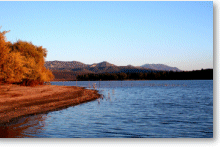 resulted in a combination of crises that led to the sale of the company's assets and the formation of a municipal utility. Walter Bothner, a retired apricot farmer and former Lake Hemet Municipal Water District board member (1968-1994), recalled that "the whole system had reached the point where it needed increasing amounts of maintenance." To supplement local water supplies during the drought, many valley residents pressed for the importation of Colorado River water. Consequently, the Eastern Municipal Water District (EMWD) was created in 1950. By tapping into Metropolitan Water District's distribution system, EMWD was successful in bringing the much needed water to western Riverside County. When EMWD was annexed to Metropolitan Water District the following year, many residents of Hemet and San Jacinto were not willing to surrender management of their water resources to outsiders. On September 27, 1955, the Lake Hemet Municipal Water District was formed following a successful bond initiative that raised sufficient funds to purchase the assets of the Lake Hemet Water Company.
resulted in a combination of crises that led to the sale of the company's assets and the formation of a municipal utility. Walter Bothner, a retired apricot farmer and former Lake Hemet Municipal Water District board member (1968-1994), recalled that "the whole system had reached the point where it needed increasing amounts of maintenance." To supplement local water supplies during the drought, many valley residents pressed for the importation of Colorado River water. Consequently, the Eastern Municipal Water District (EMWD) was created in 1950. By tapping into Metropolitan Water District's distribution system, EMWD was successful in bringing the much needed water to western Riverside County. When EMWD was annexed to Metropolitan Water District the following year, many residents of Hemet and San Jacinto were not willing to surrender management of their water resources to outsiders. On September 27, 1955, the Lake Hemet Municipal Water District was formed following a successful bond initiative that raised sufficient funds to purchase the assets of the Lake Hemet Water Company.
The centennial of the dam's construction was celebrated in 1995 with lake tours and other festivities. The following year, General Manager Leonard Hale retired after 31 years of service with Lake Hemet Municipal Water District. In 1999, a major operating valve that had been in service since 1895 was replaced, and by July 2003 more than seven miles of pipeline were replaced through the California Department of Water Resources' low interest loan program. In 2004, Lake Hemet moved through efficiency measures for organizational restructuring and improvements.
At the time of its creation in 1955, the Lake Hemet Municipal Water District had approximately 1,800 customers and a 23-square mile service area. Mirroring the rapid business and residential growth that has taken place in other locations across western Riverside County, the District's service area and customer base have also grown, including the annexation of
the Garner Valley
 community in the San Jacinto Mountains east of Lake Hemet. Today, the District serves more than 14,000 customers in a 26-square mile area that includes portions of Hemet and San Jacinto and adjacent unincorporated areas of Riverside County.
community in the San Jacinto Mountains east of Lake Hemet. Today, the District serves more than 14,000 customers in a 26-square mile area that includes portions of Hemet and San Jacinto and adjacent unincorporated areas of Riverside County.
During the second half of the 20th century, Lake Hemet Municipal Water District evolved from being primarily an irrigation service to a fully developed domestic water utility. Today, the District draws most of its drinking water from the San Jacinto Basin, while Lake Hemet and its streams that cascade down the west slope of the San Jacinto Mountains, including the North Fork and South Fork of the San Jacinto River, continue to provide important sources of irrigation water. Lake Hemet is located 4,340 feet above sea level in the picturesque San Jacinto Mountains, approximately 25 miles east of the city of Hemet in Riverside County, California.
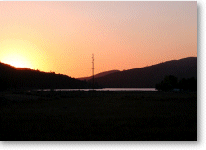 The lake is 1.5 miles long, ½ mile wide, and 135 feet deep when full. With a surface area of 420 acres of water and 4.5 miles of shoreline, Lake Hemet is a great location for family outings and weekend getaways. Open year-round, there are two public recreation areas on the lake's shores. Home to rainbow trout, channel catfish, bluegills and largemouth bass, Lake
Hemet is a popular fishing spot, and the U.S. Forest Service maintains a free fishing and picnic area for day use along the north shore. Other Lake Hemet activities include picnicking, hiking, camping, boating and kayaking. Swimming, water skiing, and sailing are not allowed because they interfere with fishing. Wildlife is abundant around the lake, and the majestic American Bald Eagle may be spotted flying overhead or perched high in the trees.
The lake is 1.5 miles long, ½ mile wide, and 135 feet deep when full. With a surface area of 420 acres of water and 4.5 miles of shoreline, Lake Hemet is a great location for family outings and weekend getaways. Open year-round, there are two public recreation areas on the lake's shores. Home to rainbow trout, channel catfish, bluegills and largemouth bass, Lake
Hemet is a popular fishing spot, and the U.S. Forest Service maintains a free fishing and picnic area for day use along the north shore. Other Lake Hemet activities include picnicking, hiking, camping, boating and kayaking. Swimming, water skiing, and sailing are not allowed because they interfere with fishing. Wildlife is abundant around the lake, and the majestic American Bald Eagle may be spotted flying overhead or perched high in the trees.
Lake Hemet is located 10 miles southeast of Idyllwild, 13 miles southwest of Palm Springs, and approximately 25 miles east of the city of Hemet. To reach Lake Hemet from Interstate 10 in Beaumont, exit on Highway 79 south (Lamb Canyon Road), turn left on Ramona Expressway, proceed to the end, turn left onto Highway 74 (Florida Avenue), and continue east 18 miles to the lake. The eastern entrance to Lake Hemet is on the right (south) side of Highway 74, just before the entrance to Garner Ranch.